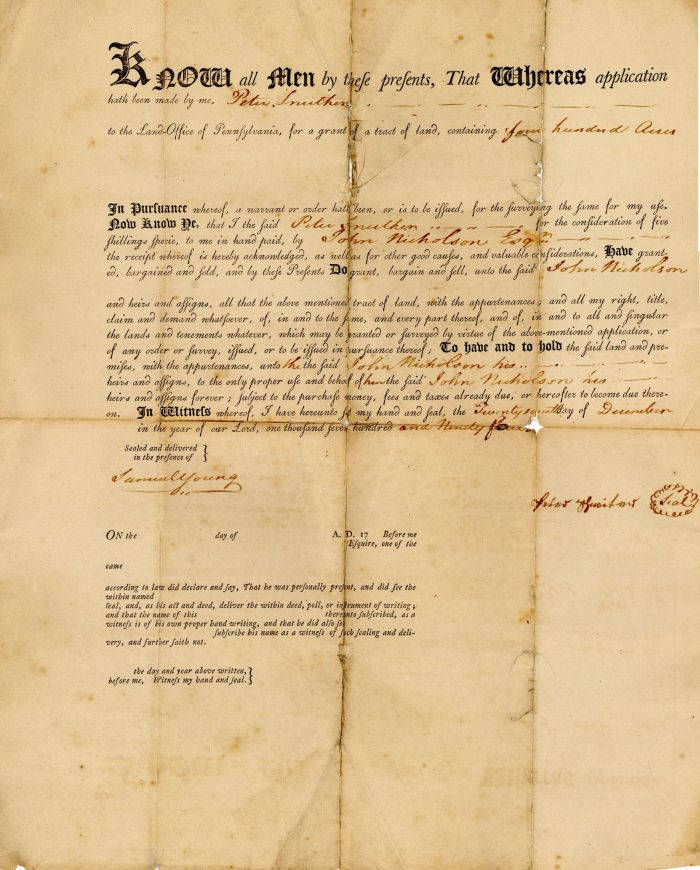Land Grant of 1794 - Americana
Inv# AM1887
Land Grant for 400 acres in Pennsylvania for John Nicholson, Esq. Repaired at folds.
A land grant is a gift of real estate – land or its use privileges – made by a government or other authority as an incentive, means of enabling works, or as a reward for services to an individual, especially in return for military service. Grants of land are also awarded to individuals and companies as incentives to develop unused land in relatively unpopulated countries; the process of awarding land grants are not limited to the countries named below. The United States historically gave out numerous land grants as Homesteads to individuals desiring to prove a farm. The American Industrial Revolution was guided by many supportive acts of legislatures (for example, the Main Line of Public Works legislation of 1826) promoting commerce or transportation infrastructure development by private companies, such as the Cumberland Road turnpike, the Lehigh Canal, the Schuylkill Canal, and the many railroads that tied the young United States together.
In America, starting in the 16th century, land grants were given for the purpose of establishing settlements, missions, and farms. England started with a headright system, used both by the Virginia Company of London and the Plymouth Colony, but later used primarily in colonies south of Maryland. Under this system, emigrants or those paying for their passage would receive land if they survived for a certain period of time (although many indentured servants did not survive their contracts and enslaved Africans were ineligible for headrights). Countries granting land included Spain, Portugal, the Netherlands, and Britain.
As English colonial law developed, headrights became patents and a patentee had to improve the land. Under this doctrine of planting and seeding, the patentee was required to cultivate 1-acre (4,000 m2) of land and build a small house on the property, otherwise the patent would revert to the government.
Between 1783 and 1821, Spain offered land grants to anyone who settled in their colony of Florida. When the United States acquired that land by treaty, it agreed to honor all valid land grants. As a result, years of litigation ensued over the validity of many of the Spanish Land Grants.
Spain and Mexico used the same system of offering land grants along the Rio Grande River near the Texas/Mexico border. These grants were given to help colonization of the area, initially by the Spanish crown, and later by Mexican authorities nationals, and strengthen frontier towns along the Texas border. During the Mexican period of California (and other portions of Mexican territories inherited from New Spain),the Mexican government granted individuals hundreds of ranchos or large tracts of land. The ranchos established land-use patterns that remain recognizable in the California of today. Controversy over community land grant claims in New Mexico persist to this day.
Future President Thomas Jefferson crafted the Ordinance of 1784 which carved out ten prospective states west of the Appalachian Mountains and established the basis for the Public Land Survey System. The Land Ordinance of 1785 provided a method for settling that land and establishing governmental institutions, which became federal land policy until 1862. The Northwest Ordinance of 1787 established the Northwest Territory, pursuant to which homesteading settlers could buy land, and certain land was set aside for public schools and other purposes. The Federal Government acquired additional lands by treaties with various Native American Tribes, such as the 1833 Treaty of Chicago by which many eastern tribes agreed to settle across the Mississippi River. Revenues from public land purchases were a major source of funding for the federal government through the 19th centuries, along with tariff revenues, since the federal income tax was not established until the 20th century.
Starting with the American Revolutionary War, United States veterans often received land grants instead of backpay or other remuneration. Bounty-land warrants, often for 160 acres, were issued to United States military veterans from 1775 to 1855, thus including veterans of the American Revolutionary War, War of 1812 and the Mexican–American War as well as various Indian wars. The land grants helped settle the Northwest Territory (and later smaller units such as the Indiana Territory, Illinois Territory and Wisconsin Territory) and as well as the Platte Purchase in Missouri. Eligibility for the warrants expanded over the years through new Congressional acts of 1842, 1850, 1852, and 1855 to the point where they could be sold or could be handed out to descendants. The warrant program was discontinued before the American Civil War.
During the 19th century, various states (or even smaller units) as well as the federal government made extensive land grants to encourage internal improvements, usually to improve transportation, such as construction of bridges and canals. The Land Grant Act of 1850 provided for 3.75 million acres of land to the states to support railroad projects; by 1857 21 million acres of public lands were used for railroads in the Mississippi River valley, and the stage was set for more substantial Congressional subsidies to future railroads. Universities were also beneficiaries of land grants. All five of the transcontinental railroads in the United States were built using land grants.
The Morrill Land-Grant Acts of 1862 and 1890 provided for the establishment of land-grant colleges.










Ebay ID: labarre_galleries